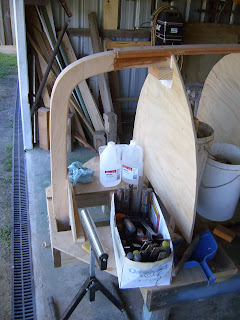In the last week I have made and glued three joints. Doesn't sound much but two of them were quite tricky and one of those two was big! Starting with the one of middle difficulty, the joint between the transom and the keelson. First step was to make the triangular brace and screw and glue it to the transom. Once this was done the lower half of the keelson (it's in two 15 mm thick pieces) was glued to the brace and held with temporary screws.
At the other end of the boat the first half of the keelson was glued and clamped to the inner stem. Once the epoxy in these two joints had set enough to hold the pieces together I applied glue to the two pieces of the keelson and put the second half in place with screws either end and clamps all along the length. Here's a photo of the stem end of things.
In the middle is the centreboard case which has to be glued into a slot cut in the keelson. The keelson is reinforced along this section by doublers to either side of it. These doubles are, like the keelson, laminated from two 15 mm thick strips. These were glued to gether and glued in place in one sticky operation, sticky for me that is. Epoxy everywhere!
Next step was to cut the slot in the keelson with a jig saw. This needed a bit of fine tuning with plane and chisel to get the case to fit. Once the slot was OK I opened out the sides about 2mm at the top to make it slightly funnel shaped, reason later.
With the board in place two plywood reinforcing pieces were glued either side to the case and to the keelson. These can be seen on the left of the photo either side of the mould. I mixed up a batch of stiff thickened epoxy and ran a small fillet around the underside of the joint between the keelson and centreboard case. This effectively sealed the bottom of the gap between the case and sides of the slot in the keelson. Once this thickened epoxy had begun to set I mixed more epoxy and poured it into the funnel shaped space from the top adding more as it settled until the joint was full.
While waitimg for all the above glue joints to set I sorted through the timber I had on hand for the masts and spars. These are all Oregon (Douglas Fir). I had toyed with the idea of making these hollow using the "birdsmouth" technique (Google "birdsmouth masts") but in the end I chickened out! They will all be solid, laminated from two strips of timber so that the opposing grain patterns resist and tendency for the wood to bend. Unfortunately I didn't have enough of the nice Oregon that I bought in a bundle from a deceased estate and will have to find a source of timber for the mizzen mast. I will work on the spars whenever there is spare time waiting while epoxy goes off.
I have built a rack against the outside of my boatbuilding shed (under an existing lean to roof) to store the spars and other timber.
I'm building a boat to a design by Paul Fisher of Selway Fisher Design in the UK. The design is called "Able" and her vital statistics are: overall length 4.88m (16ft), beam 2m (6ft 6in) and design weight is 360kg (790lbs). You can read more about this design at http://www.selway-fisher.com/OtherDB.htm#KANE.
I intend to procede more slowly with this boat than I did with either of my other boat building projects (see links below on the right). This is, after all, a hobby and there are other things to do. So, updates to this blog might happen once every week or two. Come back and see.
If you would like to contact me please Click to Send me Email
I intend to procede more slowly with this boat than I did with either of my other boat building projects (see links below on the right). This is, after all, a hobby and there are other things to do. So, updates to this blog might happen once every week or two. Come back and see.
If you would like to contact me please Click to Send me Email




No comments:
Post a Comment